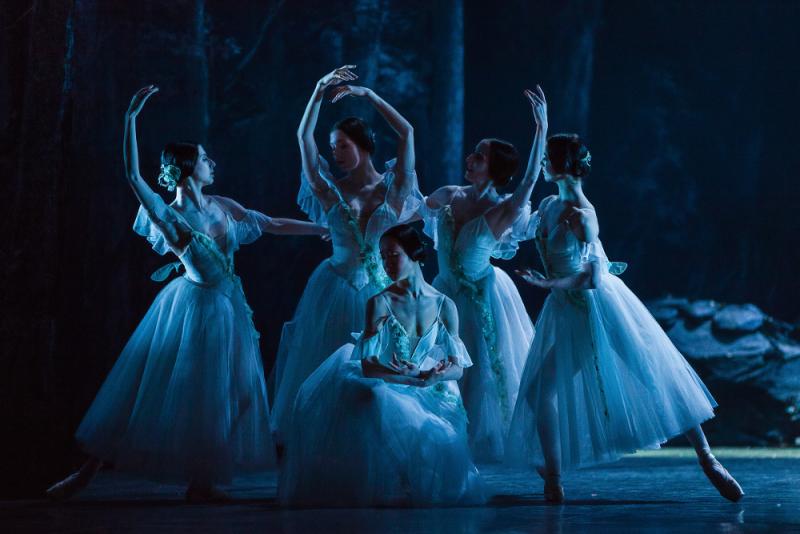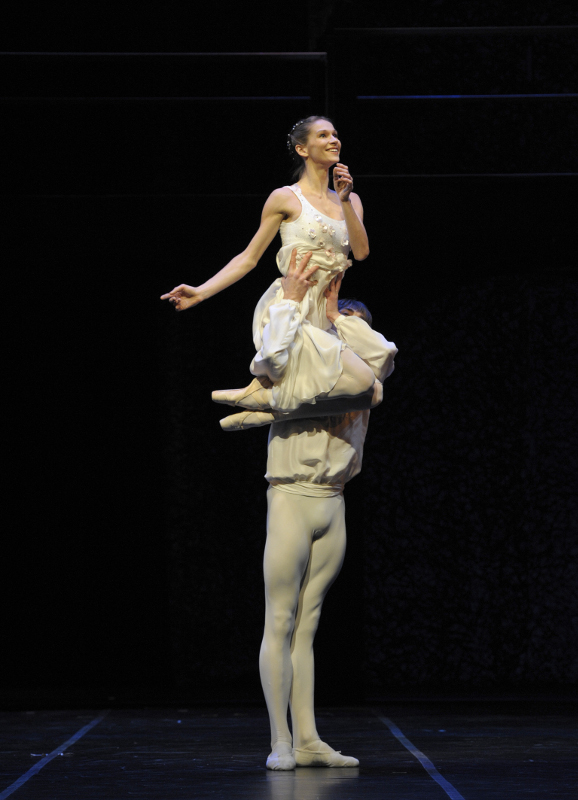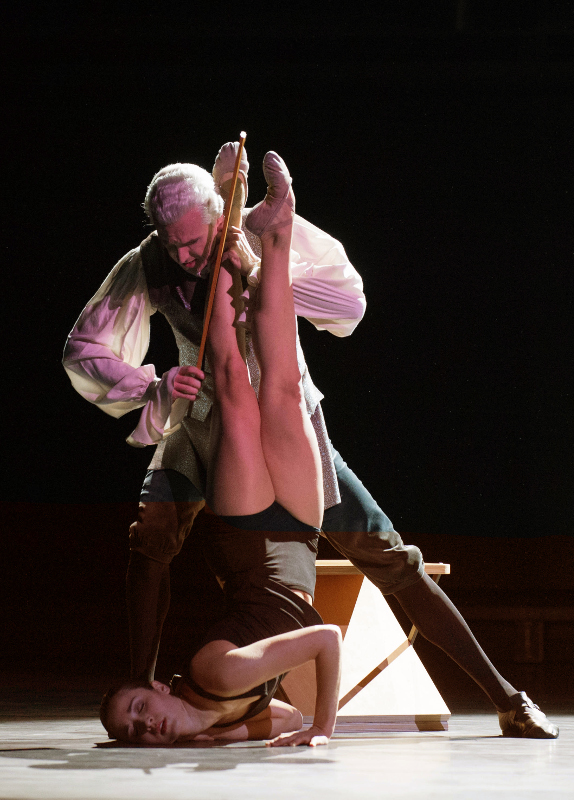theartsdesk in Berlin: Three Ballets | reviews, news & interviews
theartsdesk in Berlin: Three Ballets
theartsdesk in Berlin: Three Ballets
Versatile Staatsballett shine in Cranko, Duato, and a classic Giselle

In London, seeing the same ballet company do three different pieces in three different theatres over four nights would be some kind of festival. In Berlin, it's just business as usual – albeit quite a busy week! – for the hard-working Staatsballett.
To my mind, a company's Romeo and Juliet is almost as important a flagship as its Nutcracker. Get it right, and the combination of Shakespearean tragedy, Prokofiev score, and dance virtuosity will see every performance converting some ballet newbies into ballet fans. But get it wrong, and you run the risk of turning people off for life: my neighbour in the Deutsche Oper turned to me in horror on Wednesday night when the lights came up after Act II, "not another interval?!" She didn't come back for the last act, and though that might seem a small thing compared to the long and rousing ovations of the cognoscenti in the audience, it's a sign of a production not doing its job.

The 1962 Cranko choreography is, I am finally forced to admit (being a longstanding fan of it) inferior to the 1966 MacMillan version: though truer to the play, and with rather better crowd scenes (not MacMillan's strong point), the pas de deux in the Cranko are awkward, seeming to interrupt emotion rather than convey it. Both Semionova and Reilly have the gestural language of passion down beautifully – when he gazes at her, or she strokes his face in wonder, the sexual and romantic charge is breathtaking – but it doesn't come through in their dancing. Which, yes, may be due to under-rehearsal (the danger of shipping in principals) but the choreography cannot be absolved from blame.
The worst offender by far in this 2012 production, though, is the design: Thomas Mika has created a visual disaster. Every prop and flat is matte black (from the trees and the balcony to the wagons and fruits in the market scene) and the costumes combine moderate amounts of black velvet with truly amazing quantities of gold lamé and rose-pink satin, all lit too strongly with a too-orange light. A well-designed Cranko Romeo and Juliet would be a useful workhorse; with these designs, it's a liability.
 Rather ironically, one of the crowning moments of Duato's 1999 Multiplicity: Forms of Silence and Emptiness is all about black and pink satin: the second movement in Forms, with seven men in corsets and huge black skirts which flash cerise linings as they whirl round the men's shoulders is a piece of spellbinding showmanship. It's helped along by its D Minor organ toccata (BWV 538) score, one of the rare dramatic high points in this piece cobbled together from Bach extracts which is in its entirety rather too long and disjointed.
Rather ironically, one of the crowning moments of Duato's 1999 Multiplicity: Forms of Silence and Emptiness is all about black and pink satin: the second movement in Forms, with seven men in corsets and huge black skirts which flash cerise linings as they whirl round the men's shoulders is a piece of spellbinding showmanship. It's helped along by its D Minor organ toccata (BWV 538) score, one of the rare dramatic high points in this piece cobbled together from Bach extracts which is in its entirety rather too long and disjointed.
In the first half hour it's extremely diverting, displaying Duato's considerable talent for clever, contemporised ballet movement with a humorous edge, but it should really be a plotless one-acter, not a full-length piece attempting to tell some incomprehensible story about Bach, death and love. Being in Germany really shows up the kitschiness of having Bach on stage (pictured above left): when a man in pigtail and frock coat appears at the Komische Oper on Unter den Linden, you wonder for a moment if you're in a German culture theme park for tourists. Fine dancing again, though, from the company, among whom special mention goes to smouldering looker Kevin Pouzou and his showy, lyrical suppleness.
Dominic Hodal is one of the best Hilarions I've seen
The German theme park risk is present in Giselle too – yes, it's a French ballet, but set in the forests of the Rhineland, that quintessentially German Romantic landscape. But the visuals are by Peter Farmer, reliable purveyor of classic ballet designs and while the set is woodsier than John Macfarlane's eerie one for the Royal Ballet Giselle, it's not at all kitsch – think the dense oaks and tiny log cabins of Albrecht Altdorfer paintings. French choreographer Patrice Bart has done the story and choreography by and large sympathetically – though it's a shame to miss the full pas de six – and with a care to keep the action moving briskly along. No one has to stand around mooning for long in this Giselle, though the trade-off is that the corps in their Act I guise as peasants are on-again, off-again like American footballers.
Guest star Maria Eichwald is a cracking Giselle. With her elfin face and gossamer arms she can do the frailty of weak-hearted Giselle no problem, but she's also got strength and poise in spades to be the Wili who defies the others to defend her man. Eichwald specialises in rock-steady penchés (a kind of moving arabesque) but never just for show; her dancing is impeccably harnessed to the story she needs to tell. Company principal Mikhail Kaniskin is a splendid Albrecht, playing the philandering Duke with a nice aristocratic swagger, but genuinely running the gamut of emotions in his Wili-haunted second act. Dominic Hodal, one of the best Hilarions I've seen, dances and acts as well as the principals, and his death at the hands of the merciless Myrtha (Aurora Dickie) and the rest of the corps is absolutely top-notch ballet theatre – as is this whole production, long may it reign.
- The Berlin Staatsballett are performing Romeo and Juliet, Multiplicity: Forms of Silence and Emptiness, and Giselle in repertory in the Spring/Summer season 2016
rating
Explore topics
Share this article
The future of Arts Journalism
You can stop theartsdesk.com closing!
We urgently need financing to survive. Our fundraising drive has thus far raised £33,000 but we need to reach £100,000 or we will be forced to close. Please contribute here: https://gofund.me/c3f6033d
And if you can forward this information to anyone who might assist, we’d be grateful.

Subscribe to theartsdesk.com
Thank you for continuing to read our work on theartsdesk.com. For unlimited access to every article in its entirety, including our archive of more than 15,000 pieces, we're asking for £5 per month or £40 per year. We feel it's a very good deal, and hope you do too.
To take a subscription now simply click here.
And if you're looking for that extra gift for a friend or family member, why not treat them to a theartsdesk.com gift subscription?
more Dance
 Help to give theartsdesk a future!
Support our GoFundMe appeal
Help to give theartsdesk a future!
Support our GoFundMe appeal
 Nutcracker, English National Ballet, Coliseum review - Tchaikovsky and his sweet tooth rule supreme
New production's music, sweets, and hordes of exuberant children make this a hot ticket
Nutcracker, English National Ballet, Coliseum review - Tchaikovsky and his sweet tooth rule supreme
New production's music, sweets, and hordes of exuberant children make this a hot ticket
 Matthew Bourne's Swan Lake, New Adventures, Sadler's Wells review - 30 years on, as bold and brilliant as ever
A masterly reinvention has become a classic itself
Matthew Bourne's Swan Lake, New Adventures, Sadler's Wells review - 30 years on, as bold and brilliant as ever
A masterly reinvention has become a classic itself
 Ballet Shoes, Olivier Theatre review - reimagined classic with a lively contemporary feel
The basics of Streatfield's original aren't lost in this bold, inventive production
Ballet Shoes, Olivier Theatre review - reimagined classic with a lively contemporary feel
The basics of Streatfield's original aren't lost in this bold, inventive production
 Cinderella, Royal Ballet review - inspiring dancing, but not quite casting the desired spell
A fairytale in need of a dramaturgical transformation
Cinderella, Royal Ballet review - inspiring dancing, but not quite casting the desired spell
A fairytale in need of a dramaturgical transformation
 First Person: singer-songwriter Sam Amidon on working in Dingle with Teaċ Daṁsa on 'Nobodaddy'
Michael Keegan-Dolan’s mind-boggling total work of art arrives at Sadlers Wells this week
First Person: singer-songwriter Sam Amidon on working in Dingle with Teaċ Daṁsa on 'Nobodaddy'
Michael Keegan-Dolan’s mind-boggling total work of art arrives at Sadlers Wells this week
 Akram Khan, GIGENIS, Sadler’s Wells review - now 50, Khan returns to his roots
The dancer-choreographer goes epic in a show that unites South Asian dance styles
Akram Khan, GIGENIS, Sadler’s Wells review - now 50, Khan returns to his roots
The dancer-choreographer goes epic in a show that unites South Asian dance styles
 Maddaddam, Royal Ballet review - superb dancing in a confusing frame
Wayne McGregor's version of Margaret Atwood's dystopia needs a clearer map
Maddaddam, Royal Ballet review - superb dancing in a confusing frame
Wayne McGregor's version of Margaret Atwood's dystopia needs a clearer map
 Pina Bausch’s The Rite of Spring/common ground[s], Sadler’s Wells review - raw and devastating
Returning dancers from 13 African countries deliver celebrated vision with blistering force
Pina Bausch’s The Rite of Spring/common ground[s], Sadler’s Wells review - raw and devastating
Returning dancers from 13 African countries deliver celebrated vision with blistering force
 Legacy, Linbury Theatre review - an exceptional display of black dance prowess
An all-too-fleeting celebration of black and brown ballet talent that demands a reprise
Legacy, Linbury Theatre review - an exceptional display of black dance prowess
An all-too-fleeting celebration of black and brown ballet talent that demands a reprise
 National Ballet of Canada, Sadler's Wells review - see this, and know what dance can do
Yet again, Crystal Pite proves herself a ferocious creative force, alongside fellow Canadian exports James Kudelka and Emma Portner
National Ballet of Canada, Sadler's Wells review - see this, and know what dance can do
Yet again, Crystal Pite proves herself a ferocious creative force, alongside fellow Canadian exports James Kudelka and Emma Portner

Add comment